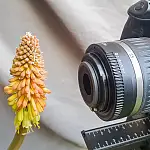Getting the Perfect Focus Every Time - Tips and TricksDon't get frustrated by blurry photos. Use our tips and tricks for getting perfect focus every time - no matter what type of camera you use!
For the vast majority of our landscape photographs, we desire that each and every element of the composition - from the tiniest foreground detail to infinity - be focused to an acceptable level of sharpness, barring any instances in which we are creatively using blur or purposefully defocusing elements of a scene.
Understanding that there is only one specific and exact position of the focus ring on our lens to get crisp focus for any stationary object at a given distance from the camera is the key to mastering focus.
An object will become out of focus if the focus ring is moved from this setting or the focus distance is altered. However, the degree of "out of focus-ness" will be so slight with just a minor initial alteration that it won't be noticeable. The degree of "out of focus-ness" increases when we look through the camera viewfinder and move the focus ring; at some point, it will become obvious to our human vision that the original object is, in fact, out of focus.
It is a good idea to test your lens before you begin. Finding your lens's sweet spot is an excellent idea. Diffraction causes a progressive loss in sharpness even at the widest aperture feasible when we stop down. However, the optical shortcomings of the lens are most noticeable at the widest apertures. The minimal degree of diffraction-induced sharpness is countered by the lack of image sharpness caused by these optical defects. The sweet spot for an f/4 lens will be around f/8 because most lenses produce their finest images when stopped down around two stops from their widest aperture.
By mounting the camera on a tripod, switching to aperture priority, and manually focusing the lens, you may test this. Afterwards, snap identical scenes using each available aperture. It should be evident when viewing the photos at 100% on a computer which apertures result in the sharpest images.
Using Autofocus Like a Pro for Perfect Focus
Have you ever tried to take a picture only to hear your lens scrambling to find focus?
Your DSLR's focusing system uses contrast-rich regions of a scene to lock on and focus the lens. Your camera could fail to locate enough contrast in low-contrast environments, like a clear sky or huge expanses of one colour, for the focus mechanism to function. This is why you hear and see the lens hunting.

To avoid this issue, attempt to place the AF points over an area of high contrast then halfway push the shutter button to initiate autofocus. Good targets for your autofocus system to lock on to include bold texturing or clearly defined edges. You can then arrange your photograph and fully depress the shutter button to capture the picture.
Depth of Field
Depth of Field is the term we use to describe the distance between the nearest and most distant objects in a scene that appear acceptably sharp.
Three factors affect the depth of field while taking landscape photos for any particular camera and lens combination. The choice of aperture, the focal length of the lens and the circle of confusion. Let's examine each separately.
The iris blades in the lens close down to a smaller diameter hole just before the exposure is made when a lower aperture (a bigger f/number, like f/22) is used. A high aperture, such as f/2, will result in photos with shallow focus, and a small depth of field, while lower apertures will improve front-to-back sharpness.

The focus length chosen on the lens is the second factor that determines the depth of field after the choice of aperture. We tested our lens, and we are aware that f/8 is the sweet spot for optimum sharpness.
Take a moment to picture ourselves on a lake's edge. Using a 24mm lens, we have framed our picture to include a highly noticeable foreground rock that is 2 metres away from the camera. Our background consists of some trees in the distance. We would exactly focus on the rock if we wanted it to be part of the image that was the best in focus. The focusing ring's distance scale would read 2m, which is roughly the distance at which the lens is focussed. In the viewfinder, the picture would appear ideal, but when we made a print, we might have been a little let down to realise that the trees in the distance were all quite blurry.

This is because a 24mm lens focused at 2m and set at f/8 produces a depth of field that is only about 5m wide. Anything up to six metres away would be acceptable, but anything farther away would not.
Things would have been much better if we had focused the lens at 3 metres, which would have caused the rock to appear somewhat blurry in the viewfinder. The depth of field that would result would range from 1.5 metres to infinity. The depth of field is maximised when focusing at 3 metres with a 24mm lens set to f/8. This is referred to as "hyperfocal distance," which we will examine in more detail in a moment.
The Circle of Confusion is the last consideration to maximise depth of field. It's a challenging idea to comprehend, and it's even harder to describe. In the simplest words possible, it is a measurement of the focal point, which is a point of light that falls on the focal plane (camera sensor). When the light converges at this location, the Circle of Confusion is measured.
The value is entered into formulae to calculate the depth of field and hyperfocal distance in fractions of millimetres. Its goal is to account for the fact that when we use a magnifying glass to make much larger prints from the images acquired on our relatively small camera sensors, we also magnify their flaws. When our lens was focused at a distance of 3 metres, we magnified the rock's minute degree of out-of-focus; the larger the final print, the more obvious the degree of defocus.
Calculators for determining the depth of field use the Circle of Confusion (CoC), a characteristic of the camera, lens, and focal length.
Perfect Focus Using Hyperfocal Focusing
Critically crisp pictures are achieved mostly through hyperfocal focus. It is described as the closest point at which a lens can focus while maintaining acceptable sharpness for objects at infinity.
It is possible to determine the focus distance that will offer the best depth of field for a specific CoC for any focal length and aperture combination. The ability to focus at this hyperfocal distance will help to produce images with the highest level of front-to-back sharpness. All objects from half the hyperfocal distance to infinity will appear to be in focus when focused at the hyperfocal distance.
What does that mean, then? Do we need to bring a tape measure? If we choose a low enough CoC and measure the hyperfocal distance from the camera to focus on an object at this precise distance, the image will have flawless front-to-back sharpness for large prints. This is useful when photographing scenes with tight foreground detail.
| mm | 17 | 20 | 24 | 28 | 35 | 50 |
|---|---|---|---|---|---|---|
| f/8 | 1.2 | 1.7 | 2.4 | 3.3 | 5.1 | 10 |
| f/11 | 0.8 | 1.2 | 1.8 | 2.5 | 3.6 | 8.4 |
| f/16 | 0.5 | 0.8 | 1.2 | 1.6 | 2.5 | 5.2 |
| f/22 | 0.3 | 0.6 | 0.9 | 1.2 | 1.8 | 3.7 |
Chart of typical hyperfocal distances (in metres) for a full-frame sensor for a given aperture and focal length.
Rarely do even the most devoted photographers have tape measures on them. Usually, one needs to gauge the distance, pick a pertinent target, and then concentrate on it. Here, extra caution is required. Recall how much of an impact it had when we chose to focus at 3 metres as opposed to the rock at 2 metres away. The traditional technique of focusing a third of the way into the scene is unreliable with such a limited degree of tolerance. It is simple to envision how even the smallest mistake in distance estimation could result in a catastrophic loss of sharpness in our resulting photographs.
Perfect Focus Using Infinity Focusing
There is an alternative technique if hyperfocal focusing all seems like a lot of work (you're not alone). Hyperfocal distance, which I previously defined as the closest distance at which a lens may be focussed while maintaining an acceptable level of sharpness for objects at infinity. This definition is useful because it lets us know that when we focus on the hyperfocal distance, any objects from half the hyperfocal distance to infinity will seem crisp.
The hyperfocal distance can also be defined as the distance beyond which all objects are sufficiently sharp for an infinity-focused lens. Infinity focussing is based on this definition.
Focusing the lens to infinity for each shot is referred to as infinity focusing. It's easy to use and, for the most part, really effective.
I only ever use this method with wide-angle lenses (24mm or wider) when capturing compositions with foreground elements because they have a sufficient depth of field for it at any given aperture. Second, I always make sure that the nearest foreground items are within the calculator tool's advised depth of field. This entails making sure that nothing in the foreground is closer to the camera than the hyperfocal distance.
A word of caution: avoid spinning the focus ring in the mistaken belief that you are focused on infinity. You must use the infinity symbol on the focus ring to precisely concentrate on infinity.











